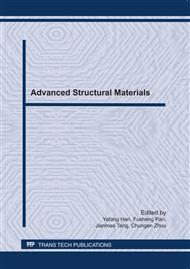[1]
Asian Metal Ltd: The Annual Report of SiC Market for 2008 (2009) , p.1.
Google Scholar
[2]
Zhang Niandong: Technology of Silicon Carbide Grain (China Machine Press, Beijing, 1982).
Google Scholar
[3]
E.G. Acheson, U.S. Patent 492, 767. (1893).
Google Scholar
[4]
M.V. Swain: Structure and Properties of Ceramics-volume 11 of Materials Science and Technology. (Translated by Guo Jingkun, et al. Science Press, Beijing, 1998. pp.156-163; 206-21).
Google Scholar
[5]
Dai Changhong, Yang Jingyi and Lin Yusheng: submitted to Journal of Qingdao Institute of Chemical Technology (1999).
Google Scholar
[6]
Wang Xiaogang, Liu Yongsheng and Li Xiaochi, et al: submitted to Xi'an University of Science & Technology Journal (2001).
Google Scholar
[7]
Liu Yongsheng, Wang Xiaogang and Li Qiang, et al: submitted to Ceramics Engineering (2001).
Google Scholar
[8]
Wang Xiaogang, Guo Jihua and Li Chengfeng: submitted to Journal of Inorganic Materials (2005).
Google Scholar
[9]
Li Xiaochi, Wang Xiaogang and Guo Xiaobin: submitted to Journal of Inorganic Materials (2003).
Google Scholar
[10]
Wang Xiaogang, Li Xiaochi and Guo Xiaobin: submitted to Journal of the Chinese Ceramic Society (2002).
Google Scholar
[11]
Pan Qunxiong, Wang Luming and Cai Anlan: The Foundation of Inorganic Materials Science (Chemical Industry Press, Beijing, 2007).
Google Scholar
[12]
former China Petroleum chemicals corporation: SH0527-92, The Quality Standards of Delayed Petroleum Coke (1992).
Google Scholar
[13]
A.A. Агроскин: submitted to Non-ferrous Metal (USSR). (1979).
Google Scholar
[14]
D.F. Varfolomeev, E.V. Artamonova and G. S. Degtyarev: submitted to Chemistry and Technology of Fuels and Oils (1986).
Google Scholar
[15]
Lin Tairui: The Introduction of Heat and Mass Transfer in Porous Materials (Science Press. Beijing, 1995).
Google Scholar
[16]
A. Devpura, P.E. Phelan and R.S. Prasher: Inter Society Conference on Thermal Phenomena, IEEE (2000), pp.21-28.
Google Scholar
[17]
Zhang Hailin: Theoretical and Experimental Research on The model Accuracy Improvement of Effective Thermal Conductivity of the Disperse System [D] (North China Electric Power University, Beijing, 2004).
Google Scholar
[18]
Yang S.R., Zhang H.L. and Xu Z. M: 3rd International Symposium on Heat Transfer Enhancement and Energy Conservation (2004), pp.992-998.
Google Scholar
[19]
D.A. Zumbrunnen, R. Viskanta and F.P. Incropera: submitted to Int. J. Heat Mass Transfer (1986).
Google Scholar
[20]
Wang Jiaofang, Yue Xianjun and Song Shuzhen, et al: submitted to Journal of Shandong Building Materials College (2000).
Google Scholar
[21]
Liang Guoping: Finite Element language (Science Press, Beijing, 2008).
Google Scholar
[22]
Liu Guangqi, Ma Lianxiang and Liu Jie, et al: Chemistry and Chemical Industry physical property manual (Chemical Industry Press, Beijing, 2004).
Google Scholar
[23]
Barin: Thermochemical Data of Pure Substances (Translated by Cheng Nailiang, et al. Science Press, Beijing, 2003).
Google Scholar
[24]
Y.S. Touloukian, R.W. Powell and C.Y. Ho, et al: Thermophysical Properties of Matter, Vol. 2, Thermal Conductivity (Nonmetallic Solids) (Plenum, New York, 1970).
Google Scholar
[25]
Yang Shiming, Tao Wenquan: Heat Transfer (4th ed) (Higher Education Press, Beijing, 2006).
Google Scholar
[26]
Element Computing Technology co. ltd: The Finite Element Method on FECsoft (2009).
Google Scholar
[27]
Zeng Pan: Finite Element Analysis and Applications (Tsinghua University Press, Beijing, 2004), pp.50-61.
Google Scholar
[28]
Element Computing Technology co. ltd: The User's Manual of FECsoft (2009).
Google Scholar
[29]
Lv Yongbo: Systems engineering (revision). (Tsinghua University Press, Beijing, 2006), pp.33-41.
Google Scholar


